Written by Andrea Batista Schlesinger and Mary Jiang
City leaders are being called upon to use the power they have to make systemic changes. One power examined far too infrequently comes in the form of the billions of dollars that flow through city coffers and then through the commercial banks that manage local government transactions. The actions of commercial banks shape cities and their economies more than any mayor’s economic development policy. Historically, these actions have reinforced White ownership and Black poverty.
The relationship between banking and inequity consistently surfaces in our work. For example, the average loan approval rate for White business owners is 19% higher than for Black business owners and only 49% of Black-owned firms survived the past recession, compared to 60% of White-owned firms. As Black protestors have argued in response to the looting that has coincided with the peaceful protests of George Floyd’s murder at the knees of police, “[These buildings are] not ours. We don’t own anything. We don’t own anything.”
The lack of Black ownership, even in Black communities, is not a coincidence. The role of private finance in the perpetuation of racial disparity did not end with redlining—race and racism remain encoded in seemingly neutral concepts, such as financial “opportunity” and “risk.” The wholesale purchase of financially distressed homes in low-income Black communities presents an “opportunity.” Yet Black and Latinx households are less likely to qualify for conventional mortgages than White applicants even when controlling for income and loan size, because they pose a greater “risk.” Predatory lending to Black communities presents an “opportunity.” Yet because of historical and structural bias amounting to perceived “risk,” Black and Latinx entrepreneurs receive lower levels of conventional business financing, are discouraged from entering capital markets, and are underrepresented in business ownership.
These patterns intensify in the aftermath of natural and economic disasters. In the Paycheck Protection Program’s first round, businesses owned by people of color were disproportionately and functionally excluded from federal aid because they did not have relationships, or large payrolls, with mainstream banking institutions. Only 12% of Black and Latino business owners who applied for COVID-19 relief aid from the Small Business Administration reported receiving what they had asked for. These barriers have had lasting effects on the second round of funding, compounding the challenges of recovery. Despite these gaps in service, banks have profited from being the only options for their services: in the PPP’s first round alone, banks earned $10 billion in fees for processing essentially zero-risk loans with reduced vetting requirements.
We cannot make cities more equitable until we confront the role of private capital in perpetuating racism. As banking reform advocate Ameya Pawar argues, every decision a bank makes to lend or not lend, invest or not invest, serve or not serve, amounts to an economic development policy. Cities can influence these decisions by committing to full transparency about the accounts they hold with commercial banks, leveraging the scale of their accounts to influence commercial banks to reform lending practices, diverting public funds to local and regional banks and Community Development Financial Institutions (CDFIs) that meet the gaps left by large commercial banks, and providing essential technical assistance to build financial capacity in underserved communities.
Beyond these steps, some have urged local governments to create an alternative to commercial banking altogether by depositing government funds in, and processing their transactions through, public banks that are owned and operated by cities or states, oriented toward the public good, and directly accountable to publicly elected bodies. In the U.S., advocates have argued that public banks could serve as alternatives to commercial banks while collaborating with mission-aligned financial institutions such as local banks, credit unions, and CDFIs. Public banks could resist the prevailing risk/return principles defined by private loan terms to drive low-interest loans and investments in Black and Brown communities that have been disqualified from the most basic levels of financial support.
We have begun to explore how public banking might work in cities across the country. We evaluated the feasibility of a public bank for the City of Seattle and are currently doing so for the City of Philadelphia. In Seattle, the primary motivation to explore an alternative to commercial banking was to divest from Wells Fargo, which had been instrumental in funding the Dakota Access Pipeline. In Philadelphia, where we estimated a small business lending gap far greater than any suite of public programs could fill and where only 5% of bank and credit union branches are located in low-income, majority-minority neighborhoods, city leaders are interested in addressing deeply entrenched, racialized poverty by seeing how their dollars could leverage investment in local businesses that would create local jobs.
Setting up public banks is not easy, and while advocates for public banks inspire us to think boldly, oversimplifying the feasibility of establishing such institutions will not advance racial and economic equity. The credit rating agencies emerged powerfully from the 1970s’ urban fiscal crises to limit government risk, effectively exerting a stranglehold on city spending and making it difficult for cities to secure the initial dollars to capitalize a bank. The heralded Bank of North Dakota, the country’s longest running and most successful public bank, took 30 years to become profitable and owes much of its initial momentum to the state’s agriculture and oil industries. Many jurisdictions, particularly cities, are fighting for a public bank in fundamentally different economies. The U.S. still lacks a precedent for a City-owned public bank, and many cities face state-level preemption challenges and limited scale of deposits, compared to state counterparts.
Local, state, and federal banking policy change will be necessary to facilitate the creation of public banks. Change is necessary because we are committed to helping cities become less dependent on private actors, such that they have a choice about how to conduct business in ways that are consistent with their values. In this way, we see our ongoing public banking work as a way of advancing the autonomy and creativity of municipal governments, and the possibility of those who live in cities to hold them accountable. Which is to say, the case for public banks is as much about supporting the use of banking powers in the public interest and challenging a commercial banking system that has profoundly failed—at scale—to move capital to advance racial and economic justice, as it is about actually setting up such banks. Perhaps even the rhetorical threat of a public bank might inspire commercial banks to embrace an anti-racist future for the cities they serve. If it doesn’t, more and more cities will begin to take their financial power elsewhere.
Our industry must embrace racial equity and shared prosperity as its core mission
I have spent much of my career working with local governments to shape inclusive economic development policy. The events of the past month have caused me to question traditional approaches to economic development, even the most progressive. A seismic shift is required for the economic development profession to contribute to ending systemic racism rather than continuing to perpetuate it.
Written by Cary Hirschstein
Most state and local governments deploy economic development resources to attract new jobs and secure capital investment. The term “trickle-down economics” has typically been reserved for federal economic policy, but most state and local economic development regimes follow a similar formula: we assume that if we grow the economy, we will generate opportunity for all and/or expand fiscal resources to support communities in need. Cities seek to attract high-wage jobs because they will pay higher taxes and drive greater spending within the local economy. This approach is built on a faulty premise: that growth yields equitable prosperity.
Economic development policy has transformed the American city while deepening racial divides. The core visions, initiatives, and tools of economic development have facilitated the return of investment to our downtowns, creating vibrant places where talent wants to be and businesses want to grow. At the same time, the imperative to “build on strength” tends to steer resources to White neighborhoods and central business districts. Prior to recently enacted policy changes, we found that parcels in one affluent, predominantly White neighborhood in Columbus, OH were three times more likely to have received property tax abatements than a comparison set of less affluent, predominantly Black communities. In Houston, 10% of the city’s property tax base is collected within its 26 Tax Increment Reinvestment Zones (TIRZ). The four wealthiest TIRZs combined retain more tax increment than the remaining 22, which they are able to reinvest locally. Studies examining federal expenditures to promote economic mobility show that benefits accrue predominantly to middle- and higher income households and limit intergenerational mobility for low- and moderate-income families.
Equitable prosperity is not a core mission of most “economic development” departments; rather it is the domain of “community development” entities. Although some cities have begun to merge community and economic development functions, they remain for the most part siloed. Economic development functions are generally better resourced than community development. Programs like workforce development and small business support that don’t involve headline-garnering, multimillion-dollar deals are often shunted to the margins of agency hierarchies.
Economic development professionals must embrace creation of shared prosperity and an equitable economy as core missions. Some City-led economic development departments have begun to employ equity as a primary lens for evaluation and deployment of their resources. We need to ensure these practices become the norm across the country, but also that they go far deeper to disrupt systemic racism. While we continue to invest in the renewal of our cities, we must also ask: who do our investments benefit, and how can those benefits be more equitably distributed? I offer five responses:
- Shift resources to investments that promote racial equity. Cities should view their economic development expenditures and assets as an investment portfolio, a primary objective of which is to create more equitable local economies. Realizing this objective will require a close examination of the beneficiaries of past investments; a deliberate shift in target recipients, geographies, and tools deployed to reach them; and far greater transparency and accountability for the deployment of resources. The potential impact is immense. A 2016 New York Times study estimated that state and local governments provide $80 billion annually in business incentives. The foregone revenue of the 10 states with the largest tax breaks is equivalent to the annual salaries of 27,000+ teachers.
- Articulate our values, use them to structure investments, and measure their actual benefits. We need to state what we expect of those doing business in our cities and insist, not just hope, that economic growth be a springboard for equitable opportunity. For those incentive deals we choose to do, requirements that provide strong, measurable public benefit should be the norm without exception. For example, New York City and State’s efforts to attract Amazon established no clear relationship between incentives offered and community benefits, which would still be true were a similar opportunity to be presented today. In contrast, Prosper Portland reformulated its mission, values and programs over the past five years to make racial equity the foundation of its work. All recipients of Prosper Portland’s largest incentive program, Enterprise Zone, execute a public benefits agreement. Companies can choose from a menu of options to fulfill their agreement, including creating a diversity hiring plan, engaging with local schools, and hosting events to support entrepreneurship. Initial results are promising, in part because companies wish to attract a younger talent pool that seeks employers with principles that align with their own.
- Promote equitable access to jobs. There is a broadly shared understanding today that human capital is core to the future of local economies and that businesses follow talent. It is therefore incongruous that our economic development entities remain focused on attracting businesses rather than cultivating our workforce. Studies suggest that customized business services such as job training are as much as 10 times more effective than incentives in influencing business location decisions. To aid economic mobility, economic developers should target industry expansion opportunities that align with pathways for the existing workforce and also invest in upskilling. Cities must provide protections for low-wage workers – disproportionately Black and female. Indianapolis recently repositioned its core economic development incentives to prioritize a higher minimum wage, health and childcare benefits, workforce training, and community partnerships.
- Invest in small businesses, with an emphasis on businesses of color. As the enormity of the COVID-19 pandemic became clear, Philadelphia distributed $13.3 million in grants and zero-interest loans to 2,000 small businesses, more money than it had distributed to all businesses citywide in the past 10 years through its primary job creation program. Indy Chamber issued $6 million in small business loans, a 15-fold increase over loan activity in a typical year. In both cases, the majority of recipients were businesses of color – 75% in Indianapolis and 60% in Philadelphia. Economic development leaders with whom I’ve spoken share the view that efforts to rebuild small business strength must be sustained. A focus on minority entrepreneurship is critical to counter structural disparities. According to Brookings, Black people represent only 4.3% of the nation’s business owners despite being 12.7% of the U.S. population, and if businesses in Black communities earned and grew at the same rate as in other neighborhoods, they would see an additional $3.9 billion in annual revenue. Providing the financial and technical support to grow more Black-owned businesses will mean looking to models like Oakland, CA’s Black Arts Business and Movement District, which established a development corporation and impact fund to support Black artists and business owners.
- Transform economic development ecosystems. Community development is economic development, and cities’ institutions should align mission and coordinate investments in currently siloed entities to recognize that fact. In many cases, disruptive change will be necessary to inject new voices, establish new priorities, shift budgetary allocations, and truly transform systems. Public organizations must hire and promote leadership and staff that is more reflective of the demographics of their cities, and we must carefully consider whose voices and analyses are elevated as we refocus our work. Investments in capacity-building for local partners within the larger economic and community development ecosystem will be critical to ensure a more robust infrastructure.
There is great urgency to this work. We have seen how underlying economic inequities, matched with the indignities of the criminal legal system, have gotten us to a boiling point in our cities. The road ahead requires taking decisive action to promote racial equity and shared prosperity, including ending a decades-long experiment in economic growth absent a real commitment to equity.
Special thanks to Andrea Batista Schlesinger, Candace Damon, Leah Elliott, Gail Hankin, Jeff Hebert, Kyle Vangel, and Mary Beth Williams for their intellectual and analytic contributions to this article.

HR&A conducted an analysis of the regional impacts of the Saratoga Racetrack and found that the track produced an economic impact on the surrounding nine counties of between $186 million and $213 million per year. HR&A’s findings were eagerly awaited by local interests, and received attention in the local Albany Times Union, and Bloomberg Business Week.
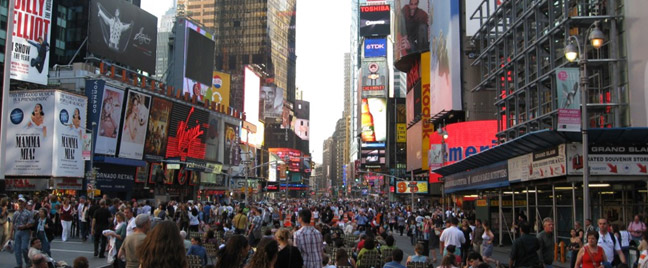
HR&A Partner Carl Weisbrod was recognized by the Center for an Urban Future as “one of New York’s most innovative economic development leaders over the past three decades” at their 15th Annual Gala. Carl joined HR&A as a Partner in 2011, and currently leads efforts to transform the Hudson Square neighborhood into a mixed-use district focused on creative industries through an innovative rezoning proposal. In addition to his role at HR&A, Carl is a Clinical Professor at New York University’s Schack Institute of Real Estate where he also serves as Academic Chair of the Concentration in Global Real Estate.
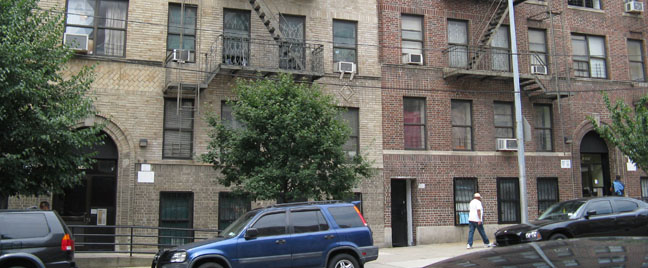
On November 8th, the New York Times published an overview, entitled “Study Clarifies the Energy Savings in Retrofitted Buildings,” of a study commissioned by Deutsche Bank Americas Foundation and Living Cities, showing how lenders can use a simple model to predict savings from installing energy efficiency retrofits, and therefore underwrite larger loans. HR&A completed this study in partnership with Steven Winters Associates.

City Parks Alliance and HR&A surveyed 58 dedicated park stewardship organizations across North America to understand their role in park management and the opportunities they create for signature city parks. Among the findings were that these organizations augment public investment with substantial private funding to improve public spaces. The typical organization sponsors 60 programs each year and provides park maintenance, volunteer recruitment, and other key functions. These parks are resourceful in securing funding, spending an average of $160,000 per acre managed, but real estate value capture remains a substantial, often untapped opportunity to support signature city parks.
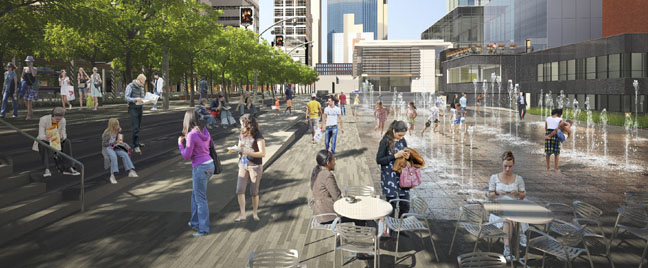
Earlier this month, the Minneapolis City Council approved the re-design of Peavey Plaza, a one-acre public space on Nicollet Mall in downtown Minneapolis, that was completed by oslund and assoc landscape architects with support from HR&A. This City-owned civic space, which has been the front yard of Orchestra Hall since the 1970s, has suffered from a lack of routine maintenance and capital reinvestment, even as its position as the primary outdoor event venue in downtown Minneapolis has taken hold. The result of a several-months collaboration between oslund and assoc, HR&A, and a committed group of stakeholders is a compelling design, programming strategy, and preliminary business model. The redesign of the deteriorating plaza was profiled in the the Minneapolis Star Tribune, which praised the plan for promising to restore safety, provide economic benefits, and incorporate sustainable design.
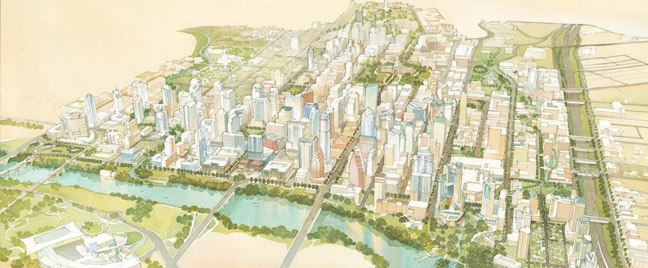
On November 3rd, Austin City Council gave preliminary approval to the Downtown Austin Plan. HR&A was pleased to support McCann-Adams Studio in creating the Plan, which supports the City’s efforts to attract and retain workers and residents to the neighborhood and strengthen Downtown’s brand.
HR&A played numerous roles in the development of the Plan.
- HR&A developed the policy rationale for a permanent density bonus, which will tie higher density Downtown for housing development to affordable housing and other public benefits. The policy is currently under review by City Council as a replacement for a temporary density bonus created during the planning stages.
- HR&A developed a strategy to increase Austin’s supply of affordable housing, recommending that workforce housing be concentrated Downtown. Our recommendations were grounded in a rigorous assessment of Austin’s current policies, workforce needs, and the state of its residential market.
- HR&A developed a comprehensive strategy for transforming Austin’s Downtown parks system. The strategy focuses on maximizing public revenues through concessions, events, and fees, and leveraging supplemental funding and management resources through collaboration with public, private and non-profit entities.
- Most recently, HR&A developed an implementation strategy for the Plan, including recommendation of a Development Corporation model to undertake a range of strategic actions Downtown.
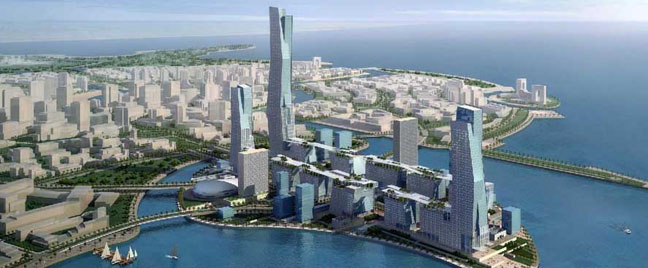
As a subcontractor to Atkins, one of the largest international engineering firms, HR&A is advising the Saudia Arabia General Investment Authority (SAGIA) and its affiliated Economic Cities Authority (ECA) on the development of four new cities in Saudi Arabia. These include King Abdullah Economic City (KAEC), a new mixed-use development about 90 km north of the major Red Sea port city of Jeddah. The master plan includes a new deep-water port, a major central business district, and numerous residential, commercial and industrial components, to meet the Kingdom’s goals for creating jobs and catalyzing foreign investment, global trade, commerce and industry. When complete, the 168 million square meter development will be home to 2 million residents. The project is being developed by Emaar, one of the world’s largest international construction and development companies.
HR&A is assisting SAGIA and ECA to design and implement an orgnizational structure for efficiently managing governmental development review and permit process for KAEC and the other three Economic Cities, and advising on various KAEC master plan implementation issues, including coastal resource and coastal access protection strategies.
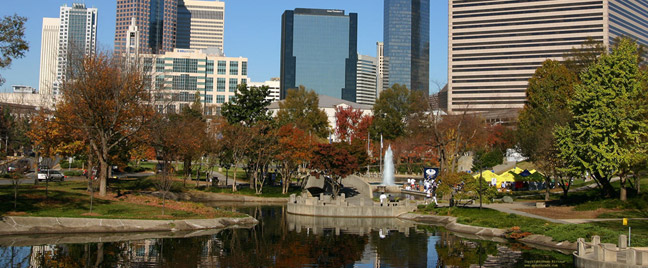
Duke Energy’s Smart Energy Now (SEN) initiative is a first-of-its-kind community behavioral change efficiency program that encourages commercial building owners, tenants, facilities staff, and employees in Uptown Charlotte to modify their current energy consumption while at work. SEN aims to ultimately cut energy use in Uptown Charlotte by 20 percent, the first 5 percent through behavior change. HR&A managed the program design on behalf of Duke Energy.
SEN has the personal commitment of local elected leadership and key Uptown Charlotte business community members, including Bank of America and Wells Fargo. It also includes partnerships with IFMA, ULI, and USGBC.